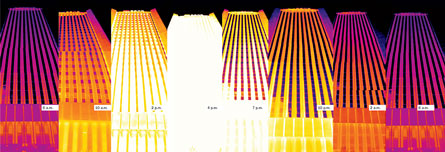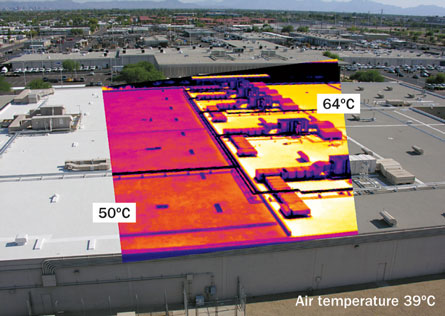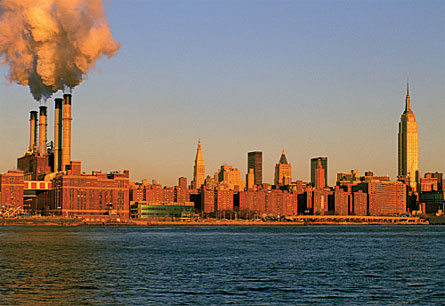Urban heat
Cities sizzle as more people move in
In life, as in boxing, the combined effects of a one-two punch are often more devastating than either blow alone. Imagine, then, the devastation from a triple whammy that city dwellers might suffer this century as three unfavorable trends converge to afflict an already warming world.
First, there’s temperature. According to the Intergovernmental Panel on Climate Change, Earth’s average global temperature has risen about 0.74 degrees Celsius in the past century (SN: 2/10/07, p. 83), an increase almost certainly linked to the rising concentrations of carbon dioxide and other heat-trapping greenhouse gases that human activities have released into Earth’s atmosphere. IPCC scientists suggest this warming trend will continue, and indeed accelerate: In the next 20 years, average global temperature will rise another 0.4 degrees C or so, they estimate.
Then, there’s population growth. Now home to more than 6.6 billion people, Earth will see its population increase by about 25 percent, or 1.65 billion, by the year 2030 (SN: 10/13/07, p. 235). Even with substantial increases in energy efficiency, this dramatically larger population will likely trigger a rise in total energy consumption, further boosting emissions of greenhouse gases.
Third, there’s urbanization. Much of the world’s population growth in coming decades will occur within cities, where residents are exposed to warmer-than-average conditions due to the “urban heat island” effect. People living in large, well-developed areas typically experience temperatures several degrees warmer than do residents of the rural areas nearby.
The confluence of these trends could create a “perfect storm” that places urban dwellers at increased environmental risk, says Walt Dabberdt, president of the American Meteorological Society in 2008. Besides the risk from rising sea levels — much of the projected population increases will be in coastal cities — urban dwellers could be exposed to more-frequent heat waves, higher levels of pollution and a myriad of health concerns (SN: 7/3/04, p. 10).
Possibly of more importance, much of the population growth will result in urban sprawl in what are now smaller metropolitan areas — a trend that will lead to dramatically larger numbers of people living within urban heat islands.
Future changes in climate, as well as the effects of those changes on regional and local weather, must be an integral part of urban planning, Dabberdt notes. The way urban heat islands affect climate overall is also important: If more people move to places that require increasing amounts of air conditioning, even more greenhouse gases will be emitted.
“Cities are major contributors to anthropogenic climate change,” says Dabberdt, who is also the Boulder, Colo.–based chief science officer for Vaisala Corp., an international manufacturer of weather-monitoring systems and instruments. Overall, he says, urban areas are directly or indirectly responsible for about 80 percent of the emissions of planet-warming greenhouse gases such as carbon dioxide. While many of those emissions are produced in the cities by industrial activity or vehicles, others are generated in coal-fired power plants that are far from the cities but are still driven by urban demand for power.
The topic of urban heat occupied many researchers who gathered in January for the 2009 annual meeting of the American Meteorological Society, held appropriately enough in Phoenix, the site of many recent studies of the urban heat island effect. While some scientists are studying how to minimize the temperature-boosting effects of urban heat islands, others are studying how urban dwellers can substantially reduce the amount of greenhouse gases that are emitted in the first place.


From farm to suburb
People have been living in increasingly large settlements ever since they gave up the hunter-gatherer lifestyle and began to cultivate the land. As agriculture became more efficient, urban populations could grow — a trend that accelerated with the Industrial Revolution and is continuing today as technology allows an ever-smaller fraction of the population to feed everyone else, says Kai N. Lee, a political scientist at the David and Lucile Packard Foundation in Los Altos, Calif.
For example, in 1740, about two-thirds of the labor force in England and Wales — the birthplace of the Industrial Revolution — worked in agriculture. A century later, as labor-saving machines proliferated, that fraction had fallen to less than one-quarter, and England was exporting surplus food to boot, Lee notes. Today, in developed nations, less than 5 percent of the population engages in agriculture, he says.
As that proportion has fallen, the percentage of urban dwellers has risen, Lee said at the AMS meeting. In 1800, only about 2 percent of the world’s population lived in cities. In 2007, for the first time, that fraction rose above 50 percent, and it’s poised to grow even more. While in raw numbers the world’s rural population is now at its peak and will probably decline slightly in coming years, urban population will continue to grow at a brisk pace. According to estimates by United Nations demographers, more than 60 percent of the world’s population will live in urban areas by 2030.
Most of that growth will take place in rapidly developing nations such as China and India and in regions such as Sub-Saharan Africa, which is already home to more urban dwellers than the combined populations of the United States and Canada, says Lee.
And the bulk of urban growth — which by 2030 will tally about 1.3 million people per week worldwide — will occur in cities that now hold less than 500,000 people. That trend will expose increasing numbers of people to urban-accentuated heat: While recent research suggests that the urban heat islands in large, long-established cities haven’t strengthened in recent decades (SN Online: “Don’t blame the cities,” 9/5/08), temperature differences between urban and rural areas in rapidly developing regions such as eastern China have increased substantially as its cities have sprawled and developed.
Cooking by day and night
In one sense, urban heat islands have been around as long as urban areas have: They just started out small and grew as cities did. Buildings and pavement typically are made of materials that have a lower albedo — that is, they absorb more of the sun’s radiation than does the natural landscape — and, during the daytime, reach higher equilibrium temperatures than surrounding objects do. At night, the buildings and streets release much of that heat. The boost in both daytime and nighttime temperatures raises the average temperature in the city.
Another often unrecognized factor that boosts urban temperatures is the proliferation of impervious surfaces, says David J. Sailor, a mechanical engineer at Portland State University in Oregon. As the proportion of rain-shedding surfaces such as roofs, pavement, sidewalks and streets goes up, the water that previously would have soaked into the ground — and later would have soaked up heat as it evaporated — simply drains away into sewers or streams (SN: 9/4/04, p. 152). Areas swaddled with impervious surfaces, in essence, heat up because the ground has lost its ability to sweat.
The size, shape and arrangement of buildings, particularly in a downtown core dense with skyscrapers, can also influence urban temperatures, Sailor said at the AMS meeting. If the heat-soaked facade of a tall building can’t “see the sky” at night — in other words, if it is surrounded by other tall buildings — any heat it gives off at night ends up warming nearby buildings rather than radiating back into space.
Finally, says Sailor, human activity generates immense quantities of heat. Burning a kilogram of gasoline generates about 45 million joules of energy, enough to melt 60 kilograms of ice and bring it to boiling. So, each car on the road with moderate gas mileage — say, 10 kilometers per liter or 24 miles per gallon — releases enough heat to melt about 4.5 kilograms, or a 10-pound bag, of ice for every kilometer it travels.
Much of the energy used in buildings — for lighting, heating and producing hot water, for example — eventually makes its way into the environment as heat.
As a rough guide, Sailor notes, one-third of the anthropogenic heat contribution to an urban heat island comes from transportation, one-third comes from buildings and one-third stems from industrial processes. Nevertheless, all cities are different: The heat island in Houston, for example, is substantially aggravated by the large number of nearby oil refineries.
Although urban heat islands are nothing new, scientists haven’t conducted many detailed investigations of the phenomenon, says Brent Hedquist, an urban climatologist at Arizona State University in Tempe. In April 2008, he and his colleagues used portable weather stations and thermal imaging cameras to carry out a round-the-clock study in downtown Phoenix. Some studies, Hedquist says, have shown that the core of that city, one of the fastest growing urban areas in the nation, is on average between 7 and 11 degrees Celsius warmer than the surrounding countryside.
A first look at the Hedquist team’s field data qualitatively confirms what many lab studies might suggest: Facades of dense concrete and brick, some of which reached temperatures of 45°C, or 113°F, during the day, retained heat well into the night, while glass and metal cooled rather quickly after the sun went down. The details of that warm-up and cool-down, however, will be the topic of intense analyses. “The situation downtown is very complex,” Hedquist notes, with daytime heat absorption and nighttime heat loss depending on factors such as the angle at which the sun strikes building facades, the distance between the buildings and the speed and direction of prevailing winds.
By combining the data gleaned downtown with some gathered by helicopter over the city at large, Hedquist and his colleagues intend to construct detailed computer models of the region’s landscape and how it responds to heat. Future studies, he says, will enable the team to assess how widespread changes in land cover — adding trees or installing permeable pavements, for example — might affect the size and strength of the region’s urban heat island.
A top-down approach
One way to make buildings energy-efficient is to modify their roofs, which are invariably exposed to sunlight. Home-owners may spread a little insulation in the attic, or switch to a lighter-colored shingle when it’s time to replace the roof. Large buildings, especially commercial structures, have more options.
So-called green roofs, which coat all or part of a building’s upper surface with soil and vegetation, address several urban heat island factors, says Sailor. Not only do green roofs typically absorb less sunlight, but the thick layer of soil also provides some insulation, reducing overall energy use in the building. And, Sailor notes, because the roof is designed to catch precipitation and hold it, potentially polluting runoff is reduced.
Previously, Sailor and his colleagues estimated that converting the impervious roofs of the buildings in Portland’s two-square-kilometer industrial district to green roofs would reduce daytime temperatures in the district as much as 0.5 degrees C (SN: 9/4/04, p. 152). That would reduce the demand for air conditioning, cutting even further the human contribution to the city’s heat island by reducing greenhouse gas emissions.
In the glaring heat of the American Southwest, researchers investigated the energy savings possible from a roof of a different color — a white one. By replacing a moderately reflective roof with one that is superbright, buildings can reduce their energy costs substantially, Joby Carlson, a research scientist at Arizona State University in Tempe, and his colleagues reported at the AMS meeting.
As part of the study, one of Arizona’s largest utility providers replaced half of a 20-year-old roof on one of its office buildings in Deer Valley, a Phoenix suburb. Sensors on the roof and at other spots inside the building just under the roof gathered data from mid-August to mid-September 2008. The original portion of the roof was covered with gravel that had an albedo of about 31 percent: In other words, about 69 percent of the sunlight falling on the roof in visible wavelengths was absorbed. The portion of the roof that was replaced was covered with gravel with an albedo of 72 percent, so it absorbed only 28 percent of the sunlight. “It’s bright white — you have to put on your sunglasses when you go up there for sure,” Carlson says.
The change in albedo made a big difference. On the afternoon of August 20, 2008, when air temperature at the site peaked near 41.7°C, or 107°F, the old portion of the roof heated up to 68°C. Meanwhile, the surface temperature on the roof’s newly bright-white portion rose to only 58.9°C. Underneath the roof’s cooler portion, temperatures near the ceiling were consistently about 3.3 degrees C lower than temperatures measured under the old roof.
More importantly, says Carlson, the building’s energy use during hours of peak demand for electricity decreased. Because utilities must build power plants to meet peak demand, widespread use of white roofs and other energy-saving renovations could forestall or slow the need for additional power plants that would emit more greenhouse gases, he notes. And building fewer power plants is one possible counterpunch in the fight against climate change.

Credit: Rudy Sulgan/Corbis
Heat recycling
Two-thirds of the energy locked in the coal and natural gas used to generate electricity at power plants ends up as waste heat, says Thomas R. Casten, chairman of Recycled Energy Development in Westmont, Ill. Casten and Phil Schewe of the American Institute of Physics in College Park, Md., note in the January-February American Scientist that unused heat is dumped into the environment. Were power plants closer to customers, Casten suggests, some of that waste heat could be put to work. Consolidated Edison in New York City, for example (smokestacks pictured), delivers heat to thousands of buildings in Manhattan via the world’s largest commercial steam system. Even waste heat from industrial processes could generate electricity.